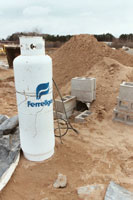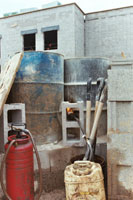Planning a masonry project this winter? Below-normal temperatures (40 degrees Fahrenheit and below) do not necessitate any significant changes of the mortar mixtures or the masonry units. Rather, your principal concern will be to keep the newly constructed masonry from freezing. Here are some pointers:
Mortar – Ideal temperatures for the placement and curing of masonry mortar is the range of 70°F + 10°F. In cold weather (40 degrees Fahrenheit and below) mortar materials need to be heated, otherwise the mortar is likely to exhibit slower setting times and lower early strengths.
Water acts as a lubricant in the plastic mortar and is required for hydration of the portland cement contained in the mortar. While mortar stiffens as water is absorbed by units and evaporates, the hardening of mortar is a result of the reaction between the portland cement and water. This reaction rate is temperature dependent and is slowed or stopped when the cement paste is below 40 degrees Fahrenheit.
During the critical early curing stages when the free water content of mortar is high (above 6 percent) the temperature of the in place masonry should be maintained above freezing to avoid disruptive expansion in the mortar due to freezing. While measures to reduce initial water content of the mortar and increase the dispersion rate of the free moisture in the masonry limits the time that the masonry is vulnerable to disruptive freezing expansion, such measures must be appropriately balanced with other considerations of good masonry practice. For example: The use of a clean well graded sand will reduce the water requirement of mortar without the detrimental loss of workability that may occur as a result of arbitrarily cutting back on the water content. Heating the mortar materials and providing heated enclosures for newly constructed masonry will increase both the dispersion rate of the free moisture and the reaction rate with the cement compounds.


Sand can be heated over fire in a pipe, and water can be heated in metal drums.
Masonry Units – Only dry masonry units should be used during cold weather masonry construction. Wet units may become frozen before construction and impair the performance of the mortar and consequently the wall assembly. Further, dry units should not be excessively cold because they will cool the mortar rapidly and could cause freezing. Cold masonry units that are wet and frozen must be thawed, but carefully, to prevent overheating. Preheated masonry units exhibit all the usual performance characteristics of units used during normal construction, except the heated unit may absorb more water from the mortar.
Absorptive masonry units do have an advantage in cold weather over units with very low absorption. The absorptive unit can absorb excess water from the mortar and lessen the possible disruptive expansion in the mortar on first freezing. However, even with absorptive units, the temperature of masonry needs to be initially maintained at a level that assures adequate curing of the fresh mortar. Units with very low absorption capability (glass block, for example) may require extended heating of the masonry to avoid disruptive freezing of the mortar. The slow stiffening of mortar resulting from the low absorption of the unit will limit productivity during construction and could contribute to color variations in mortar joints as a result of tooling wet mortar joints.
Materials – At cold temperatures, Type I cement can be replaced with Type III cements which hydrates at a faster rate. You may also consider changing to a higher strength mortar than you would normally use. For example: If ASTM C270 Type N mortar is specified for normal temperatures, the typically lower water retention and higher strength gain of a Type S mortar may be more appropriate for cold weather, particularly if low absorption masonry units are used.
Admixtures – Mortar admixtures are acceptable in cold weather masonry construction, but only if they are laboratory tested at the temperature extremes at which they will be used.
For more detail, see Cold Weather Masonry Construction, IS248, or contact the International Masonry Institute.